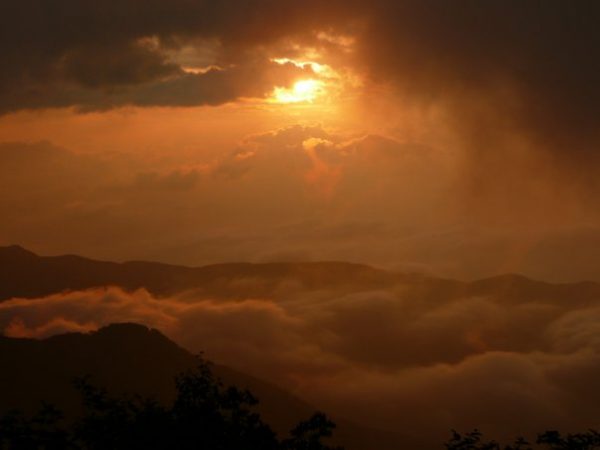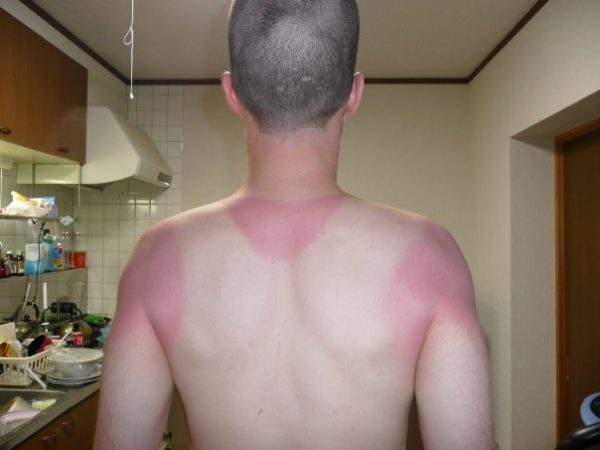The past couple of weeks have brought a wild and unpredictable variety of weather to Nagano Prefecture, with the Northern Alps in particular experiencing bouts of thunderstorm activity. Now, we often talk about weather being a constant concern for hikers everywhere in any season: heatstroke can be a problem in the summer, rain can be a dangerous annoyance even for the well prepared, and sudden drops in temperature in the mountains can be a concern at any time of year. In this entry, I’d like to address some issues related to summer conditions and the hazards they can pose.

Think summer is the safest season to go hiking? You might have a point. Winter hazards such as snow flurries and avalanches tend not to be an issue and the rhetoric about always preparing for the season before and the season after is less daunting. But there are still some key points to consider.
1. Sunburn, Heatstroke, and Dehydration
At around 1,200m above sea level, Kamikochi is renowned for being cool and breezy in the summer even as down below in the cities and towns people are sweating out 35-40 degree temperatures. But this feeling can also lull you into a false sense of invulnerability to the heat.
Many people don’t realize that, at high altitudes, the UV count can be very high making sunburn a risk for anyone who hasn’t covered up with suitable clothing and dabbed some proper sunscreen on. In addition to long term risks of skin cancer, burns can cause great discomfort as well as aggravating other heat-related conditions.
Heatstroke can also be a problem since people exerting themselves in even moderate summer heat will naturally feel hotter and sweat more, leading to fatigue, dehydration and other hazards. Left untreated, heatstroke can even cause long term damage to vital organs. Given the choice, you don’t want to experience any of this.
The Mayo Clinic website offers the following helpful tips one avoiding heatstroke: http://www.mayoclinic.org/diseases-conditions/heat-stroke/basics/prevention/con-20032814
For our part, we’d like to stress these points:
–Stay hydrated. This is an absolute mountain essential. Never attempt a long hike without ample water and some knowledge of where to refill it.
–Hack a proper hat. Hats do a lot of the hard work often trusted to sunscreen. Using both is advisable, but be careful not to lose your hat on windy peaks!
–Start your hike early. This will minimize time spent exerting yourself during the hottest periods of the day.

Exercise discretion when preparing your gear and changing in and out of clothing. For anyone planning a long hike, cotton clothing should be substituted with breathable, quick dry synthetics. If you find yourself stuck in sweat soaked garb when the temperature drops in the evening, prepare for added discomfort and possible danger. A wealth of options is a good thing with changes in clothing helping you stay dry and comfortable. For sunscreen you’ll want at least a 50. And don’t trust the products’ claims to being waterproof or sweat proof. That sunscreen will come off over the course of a few hours, so keep re-applying it. Just this past weekend in the Togakushi area, I suffered moderate burns on my face, arms, and legs, despite having applied and re-applied cream and spending most of the hike under the cover of trees!
2. Rainfall and Lightning
“When the thunder roars, get indoors” as the old adage tells us and while it might sound like the kind of platitude beloved of your uncle Gary, it’s definitely good advice. Say that you find yourself ridge walking on the Daikiretto around midday with a rest Kitahotaka Lodge only a tantalizing hour away. Despite the beautiful blue skies all around you, a rumble of thunder can be heard in the distance. But it’s too far away to pose any danger right? Wrong. Lightning can travel laterally over a 16km at terrific speeds, meaning that if you can hear it, you’re in danger of being struck.
One key strategy for minimizing this danger is to start and finish your hike early. Since in the summertime you can practically set your watch by the regularity with which thunderstorms hit in the early afternoon, you are well advised to get off the mountain as early as possible to avoid a dangerous run in. Beyond that, just do your best to spend as little time as possible in exposed areas. A few years ago, a hiker was fatally struck by lightning near the peak of Yarigatake after ignoring (or possibly not hearing) repeated warnings over the loudspeaker of a nearby lodge. It may be that as many as 90% of victims survive lightning strikes, but they are still very dangerous and cause scars and serious injuries even in non-fatal cases.
The Website Wild Backpacker offers some handy tips about lightning storms here: http://www.wildbackpacker.com/wilderness-survival/articles/surviving-a-lightning-storm/
Rainfall can present a hazard to unprepared hikers and can soak your gear in a few seconds. In addition to using rain gear and that plastic cover that came with your pack, consider “double-bagging” key items by putting them in a large clear garbage bag inside your pack.
As a final comment on this subject, we should add that you should definitely be aware of the latest weather forecast before embarking on a long hike. Please bear in mind however, that you can still be surprised by a storm on seemingly clear days. Stay alert and stay safe.
If you have any further questions about hiking and mountain walking in Kamikochi, please contact us via our Facebook page: https://www.facebook.com/kamikochi/




